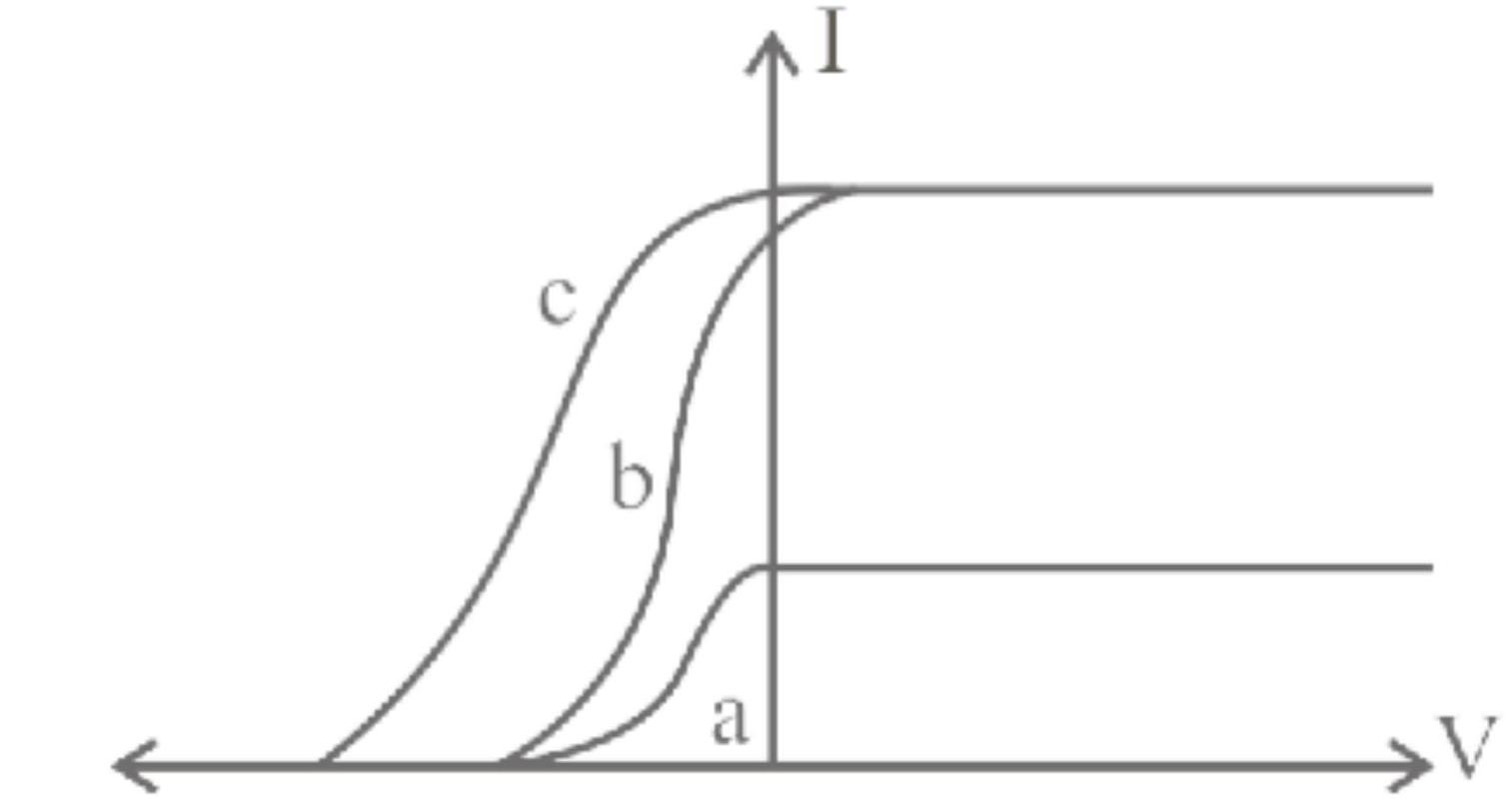142056 The threshold frequency for a certain metal is $v_{0}$. When a certain radiation of frequency $2 v_{0}$ is incident on this metal surface the maximum velocity of the photoelectrons emitted is $2 \times 10^{6}$ $\mathrm{ms}^{-1}$. If a radiation of frequency $3 v_{0}$ is incident on the same metal surface the maximum velocity of the photoelectrons emitted (in $\mathrm{ms}^{-1}$ ) is
142057 The photoelectric threshold wavelength of silver is $3250 \times 10^{-10} \mathrm{~m}$. The velocity of the electron ejected from a silver surface by ultraviolet light of wavelength $2536 \times 10^{-10} \mathrm{~m}$ is (Given, $h=4.14 \times 10^{-15} \mathrm{eVs}$ and $\mathrm{c}=3 \times 10^{8}$ $\mathbf{m s}^{-1}$ )
142059 When light of frequency $v_{1}$ is incident on a metal with work function $\mathrm{W}$ (where $h v_{1}>\mathrm{W}$ ), then photocurrent falls to zero at a stopping potential of $V_{1}$. If the frequency of light is increased to $v_{2}$, the stopping potential changes to $V_{2}$. Therefore, the charge of an electron is given by
142056 The threshold frequency for a certain metal is $v_{0}$. When a certain radiation of frequency $2 v_{0}$ is incident on this metal surface the maximum velocity of the photoelectrons emitted is $2 \times 10^{6}$ $\mathrm{ms}^{-1}$. If a radiation of frequency $3 v_{0}$ is incident on the same metal surface the maximum velocity of the photoelectrons emitted (in $\mathrm{ms}^{-1}$ ) is
142057 The photoelectric threshold wavelength of silver is $3250 \times 10^{-10} \mathrm{~m}$. The velocity of the electron ejected from a silver surface by ultraviolet light of wavelength $2536 \times 10^{-10} \mathrm{~m}$ is (Given, $h=4.14 \times 10^{-15} \mathrm{eVs}$ and $\mathrm{c}=3 \times 10^{8}$ $\mathbf{m s}^{-1}$ )
142059 When light of frequency $v_{1}$ is incident on a metal with work function $\mathrm{W}$ (where $h v_{1}>\mathrm{W}$ ), then photocurrent falls to zero at a stopping potential of $V_{1}$. If the frequency of light is increased to $v_{2}$, the stopping potential changes to $V_{2}$. Therefore, the charge of an electron is given by
142056 The threshold frequency for a certain metal is $v_{0}$. When a certain radiation of frequency $2 v_{0}$ is incident on this metal surface the maximum velocity of the photoelectrons emitted is $2 \times 10^{6}$ $\mathrm{ms}^{-1}$. If a radiation of frequency $3 v_{0}$ is incident on the same metal surface the maximum velocity of the photoelectrons emitted (in $\mathrm{ms}^{-1}$ ) is
142057 The photoelectric threshold wavelength of silver is $3250 \times 10^{-10} \mathrm{~m}$. The velocity of the electron ejected from a silver surface by ultraviolet light of wavelength $2536 \times 10^{-10} \mathrm{~m}$ is (Given, $h=4.14 \times 10^{-15} \mathrm{eVs}$ and $\mathrm{c}=3 \times 10^{8}$ $\mathbf{m s}^{-1}$ )
142059 When light of frequency $v_{1}$ is incident on a metal with work function $\mathrm{W}$ (where $h v_{1}>\mathrm{W}$ ), then photocurrent falls to zero at a stopping potential of $V_{1}$. If the frequency of light is increased to $v_{2}$, the stopping potential changes to $V_{2}$. Therefore, the charge of an electron is given by
142056 The threshold frequency for a certain metal is $v_{0}$. When a certain radiation of frequency $2 v_{0}$ is incident on this metal surface the maximum velocity of the photoelectrons emitted is $2 \times 10^{6}$ $\mathrm{ms}^{-1}$. If a radiation of frequency $3 v_{0}$ is incident on the same metal surface the maximum velocity of the photoelectrons emitted (in $\mathrm{ms}^{-1}$ ) is
142057 The photoelectric threshold wavelength of silver is $3250 \times 10^{-10} \mathrm{~m}$. The velocity of the electron ejected from a silver surface by ultraviolet light of wavelength $2536 \times 10^{-10} \mathrm{~m}$ is (Given, $h=4.14 \times 10^{-15} \mathrm{eVs}$ and $\mathrm{c}=3 \times 10^{8}$ $\mathbf{m s}^{-1}$ )
142059 When light of frequency $v_{1}$ is incident on a metal with work function $\mathrm{W}$ (where $h v_{1}>\mathrm{W}$ ), then photocurrent falls to zero at a stopping potential of $V_{1}$. If the frequency of light is increased to $v_{2}$, the stopping potential changes to $V_{2}$. Therefore, the charge of an electron is given by
